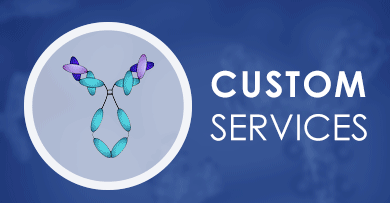 Loading...
Loading...

GRN
 Loading...
Loading...Anti-GRN Products
- Mouse Anti-GRN Recombinant Antibody (clone 5B10) (MOB-2578z)
-
- Derivation: Mouse
- Species Reactivity: Human
- Type: Mouse IgG1
- Application: WB, IHC
-
- Species Reactivity: Human
- Type: ADCC enhanced antibody
-
- Species Reactivity: Human
- Type: Mouse antibody
- Application: ICC, IF, WB
-
- Derivation: Phage display library
- Species Reactivity: Human
- Type: Rabbit IgG
- Application: ICC, IHC-P, IP, WB
-
- Derivation: Phage display library
- Species Reactivity: Mouse
- Type: Rabbit IgG
- Application: ELISA
-
- Antibody Host: Human
- Antibody Reactivity: Human
- Anti-GRN Immunohistochemistry Kit (VS-0325-XY954)
-
- Species Reactivity: Human
- Target: GRN
- Application: IHC
-
- Species Reactivity: Human
- Type: Rabbit IgG
- Application: WB, IHC-P, ICC, IF, IP, FC
- Anti-Mouse Grn Immunohistochemistry Kit (VS-0525-XY2938)
-
- Species Reactivity: Mouse
- Target: Grn
- Application: IHC
- Anti-Human GRN Immunohistochemistry Kit (VS-0525-XY2937)
-
- Species Reactivity: Human
- Target: GRN
- Application: IHC
Can't find the products you're looking for? Try to filter in the left sidebar.Filter By Tag
Our customer service representatives are available 24 hours a day, from Monday to Sunday. Contact Us
For Research Use Only. Not For Clinical Use.
Background
Disease related genes, Human disease related genes, Plasma proteins
Intracellular, Secreted (different isoforms)
Cell type enhanced (Hofbauer cells, Kupffer cells)
Group enriched (classical monocyte, myeloid DC, plasmacytoid DC, intermediate monocyte, neutrophil, non-classical monocyte)
Low cell line specificity
Progranulin is secreted as a homodimer (PubMed:23364791). Interacts with SLPI; interaction protects progranulin from proteolysis (PubMed:12526812). Interacts (via region corresponding to granulin-7 peptide) with CTSD; stabilizes CTSD and increases its proteolytic activity (PubMed:28453791). Interacts (via region corresponding to granulin-7 peptide) with SORT1; this interaction mediates endocytosis and lysosome delivery of progranulin; interaction occurs at the neuronal cell surface in a stressed nervous system (PubMed:21092856). Interacts with PSAP; facilitates lysosomal delivery of progranulin from the extracellular space and the biosynthetic pathway (PubMed:26370502). Forms a complex with PSAP and M6PR; PSAP bridges the binding between progranulin and M6PR (PubMed:26370502). Forms a complex with PSAP and SORT1; progranulin bridges the interaction between PSAP and SORT1; facilitates lysosomal targeting of PSAP via SORT1; interaction enhances PSAP uptake in primary cortical neurons (PubMed:28541286). Interacts (via regions corresponding to granulin-2 and granulin-7 peptides) with GBA; this interaction prevents aggregation of GBA-SCARB2 complex via interaction with HSPA1A upon stress (PubMed:27789271). Interacts (via region corresponding to granulin-7 peptide) with HSPA1A; mediates recruitment of HSPA1A to GBA and prevents GBA aggregation in response to stress (PubMed:27789271).
Cytokine

